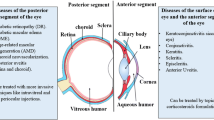Abstract
Purpose
To determine the efficacy of azithromycin 1.5% eyedrops compared with oral doxycycline in patients with moderate to severe meibomian gland dysfunction (MGD).
Methods
This prospective randomized trial included 169 participants with newly diagnosed moderate to severe MGD. Participants were randomly assigned to treatment with azithromycin 1.5% eyedrops (n = 85) twice daily for 2 days then once daily until 4 weeks or oral doxycycline (n = 84) 100 mg twice daily for 4 weeks. Signs and symptoms of MGD were evaluated at baseline and 4 weeks later. The percentages of participants with improvement in meibum quality were assessed as a primary outcome. Secondary outcomes were MGD-related symptoms, meibum expressibility, Oxford ocular surface staining score, tear film break up time (TBUT), and drug side effects.
Results
Although there were significant improvements in all outcomes in both groups, there was no between-group differences in the percentages of participants with improved meibum quality (P = 0.80), MGD-related symptoms (P > 0.05), meibum expressibility (P = 0.92), Oxford ocular surface staining score (P = 0.59), and TBUT (P = 0.99). Five (5.88%) participants in azithromycin group and four (4.76%) participants in doxycycline group discontinued medications due to drug side effects (P = 0.75).
Conclusions
Both azithromycin 1.5% eyedrops and oral doxycycline significantly improved signs and symptoms in patients with moderate to severe MGD. Both azithromycin 1.5% eyedrops and oral doxycycline showed no difference in term of improved signs and symptoms of MGD as well as drug side effects that lead to discontinuation of medication.



Similar content being viewed by others
References
Schaumberg DA, Nichols JJ, Papas EB, Tong L, Uchino M, Nichols KK (2011) The international workshop on meibomian gland dysfunction: report of the subcommittee on the epidemiology of, and associated risk factors for, MGD. Invest Ophthalmol Vis Sci 52:1994–2005
Olenik A, Mahillo-Fernandez I, Alejandre-Alba N, Fernandez-Sanz G, Perez MA, Luxan S, Quintana S, Martinez de Carneros Llorente A, Gracia-Sandoval B, Jimenez-Alfaro I (2014) Benefits of omega-3 fatty acid dietary supplementation on health-related quality of life in patients with meibomian gland dysfunction. Clin Ophthalmol 8:831–836
Nichols KK, Foulks GN, Bron AJ, Glasgow BJ, Dogru M, Tsubota K, Lemp MA, Sullivan DA (2011) The international workshop on meibomian gland dysfunction: executive summary. Invest Ophthalmol Vis Sci 52:1922–1929
Foulks GN, Borchman D, Yappert M, Kakar S (2013) Topical azithromycin and oral doxycycline therapy of meibomian gland dysfunction: a comparative clinical and spectroscopic pilot study. Cornea 32:44–3253
Kashkouli MB, Fazel AJ, Kiavash V, Nojomi M, Ghiasian L (2015) Oral azithromycin versus doxycycline in meibomian gland dysfunction: a randomised double-masked open-label clinical trial. Br J Ophthalmol 99:199–204
Veldman P, Colby K (2011) Current evidence for topical azithromycin 1% ophthalmic solution in the treatment of blepharitis and blepharitis-associated ocular dryness. Int Ophthalmol Clin 51:43–52
Opitz DL, Tyler KF (2011) Efficacy of azithromycin 1% ophthalmic solution for treatment of ocular surface disease from posterior blepharitis. Clin Exp Optom 94:200–206
Hoeprich PD, Warshauer DM (1974) Entry of four tetracyclines into saliva and tears. Antimicrob Agents Chemother 5:330–336
Thode AR, Latkany RA (2015) Current and emerging therapeutic strategies for the treatment of meibomian gland dysfunction (MGD). Drugs 75:1177–1185
Akpek EK, Vittitow J, Verhoeven RS, Brubaker K, Amar T, Powell KD, Boyer JL, Crean C (2009) Ocular surface distribution and pharmacokinetics of a novel ophthalmic 1% azithromycin formulation. J Ocul Pharmacol Ther 25:433–439
Foulks GN, Borchman D, Yappert M, Kim SH, KcKay JW (2010) Topical azithromycin therapy for meibomian gland dysfunction: clinical response and lipid alterations. Cornea 29:781–788
(2007) Methodologies to diagnose and monitor dry eye disease: report of the Diagnostic Methodology Subcommittee of the International Dry Eye WorkShop. Ocul Surf 5:108–52
Haque RM, Torkildsen GL, Brubaker K, Zink RC, Kowalski RP, Mah FS, Pflugfelder SC (2010) Multicenter open-label study evaluating the efficacy of azithromycin ophthalmic solution 1% on the signs and symptoms of subjects with blepharitis. Cornea 29:871–877
Mantelli F, Lee DC, Chang MH (2013) Topical azithromycin as a novel treatment for ocular rosacea. Ocul Immunol Inflamm 21:371–377
Yoo SE, Lee DC, Chang MH (2005) The effect of low-dose doxycycline therapy in chronic meibomian gland dysfunction. Korean J Ophthalmol 19:258–263
Knop E, Knop N, Millar T, Obata H, Sullivan DA (2011) The international workshop on meibomian gland dysfunction: report of the subcommittee on anatomy, physiology, and pathophysiology of the meibomian gland. Invest Ophthalmol Vis Sci 52:1938–1978
Geerling G, Tauber J, Baudouin C, Goto E, Matsumoto Y, O’Brien T, Rolando M, Tsubota K, Nichols KK (2011) The international workshop on meibomian gland dysfunction: report of the subcommittee on management and treatment of meibomian gland dysfunction. Invest Ophthalmol Vis Sci 52:2050–2064
Zhang L, Su Z, Zhang Z, Lin J, Li DQ, Pflugfelder SC (2015) Effects of azithromycin on gene expression profiles of proinflammatory and anti-inflammatory mediators in the eyelid margin and conjunctiva of patients with meibomian gland disease. JAMA Ophthalmol 133:1117–1123
Liu Y, Kam WR, Ding J, Sullivan DA (2015) Can tetracycline antibiotics duplicate the ability of azithromycin to stimulate human meibomian gland epithelial cell differentiation? Cornea 34:342–346
Funding
This study was funded by the Rachadaphiseksomphot Endowment Fund of Chulalongkorn University (RA57/061).
Author information
Authors and Affiliations
Corresponding author
Ethics declarations
Conflict of interest
The authors declare that they have no conflict of interest.
Ethical approval
All procedures performed in studies involving human participants were in accordance with the ethical standards of the institutional research committee and with the 1964 Helsinki declaration and its later amendments.
Informed consent
Informed consent was obtained from all individual participants included in the study.
Additional information
Publisher’s note
Springer Nature remains neutral with regard to jurisdictional claims in published maps and institutional affiliations.
Rights and permissions
About this article
Cite this article
Satitpitakul, V., Ratanawongphaibul, K., Kasetsuwan, N. et al. Efficacy of azithromycin 1.5% eyedrops vs oral doxycycline in meibomian gland dysfunction: a randomized trial. Graefes Arch Clin Exp Ophthalmol 257, 1289–1294 (2019). https://doi.org/10.1007/s00417-019-04322-1
Received:
Revised:
Accepted:
Published:
Issue Date:
DOI: https://doi.org/10.1007/s00417-019-04322-1




